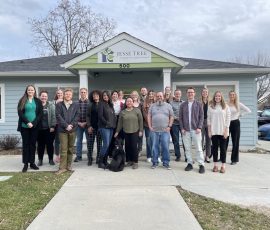If not you, who? If not now, when?
Jeff Dyer, Hal Gregersen, Clayton M. Christensen, The Innovator’s DNA
It is often stated that nonprofit organizations currently find themselves at an important time in history. A time that is characterized as volatile, uncertain, complex, and ambiguous, yet also full of opportunity. In the face of improbable societal changes, it is essential that boards and executive leaders recognize that looking ahead and embracing challenges and opportunities are fundamental to mission stewardship. In this light, organizations should continually strive to improve current programs and organizational capacities, as well as create new and hopefully better ways to serve their constituencies. In other words, organizations should nurture a culture of innovation without ignoring the need for structure and discipline.
Simply stated, innovation is “introducing something new.” Innovation is market driven. It is compelled by an organization’s desire to understand and meet the changing needs of its constituencies. Innovation, which can be the catalyst to improvement and growth, is often considered integral to a flourishing organization.
Innovation begins with an organization’s ability to accurately define its current status as well as imagine its future position. This work could represent a “new reality” (a new program, a new technology, or a whole new way of doing business) that an organization seeks to adopt as it looks to the future. It could also represent a “swamp issue,” a difficult and persistent issue that hampers an organization’s effectiveness in fulfilling its mission and may require new thinking and action. It is often addressing the problem issues “upstream,” which lead to problems “downstream.”
Innovation is a broad concept that can be distilled into several categories of innovation. Some innovations involve the delivery of a current program or service to a new audience or combining existing practices to produce something new, and therefore involve less risk. Other types of innovation may be transformative in nature or involve groundbreaking ideas or program, which carry greater risk. The following briefly describes two types of innovation, which are of greater risk:
- Transformative Innovation — addresses the systemic or underlying issues, in new ways, rather than just the symptom. Often there is no “road map” or “best practice” to follow with this type of innovation.
- Groundbreaking Innovation – introduces a concept or program that has never been done before and may be ahead of its time. Similar to transformative innovation, there is often no “road map” or “best practice” to follow.
The breadth and depth of innovation can be intimidating. However, based on the definition and the actual history of the nonprofit sector, it is more than likely that innovation, in some form, has been part of every nonprofit organization’s history. The following statements from those who work in the field offer some summary thoughts regarding innovation that may be helpful:
- Leadership has no choice but to anticipate the future and attempt to mold it. Peter F. Drucker said it well, “The best way to predict your future is to create it.”
- Innovation is not something that takes place for a few creative individuals or a handful of innovative organizations, but can be a learned skill.
- Organizations should nurture both its expansive, creative energy and its need for solid administrative services, management, and financial resources.
- Sources for innovative opportunity may involve changes outside the organization including: demographics (population changes); changes in perception, mood, and meaning; new knowledge, both scientific and nonscientific.
- Rarely does an idea or an innovation surface fully formed. No matter how well articulated a concept or insight might be, it must be shaped and modified, often significantly, as it gets fleshed out into a business plan.
- New ideas should be tested, such as some type of pilot stage.
- A crucial question for an innovative project is, “Who in our organization should really work on this?” It should be someone who is passionate and committed to the innovation, who wants it to grow, who deeply believes in it. It needs to be someone with focus, persistence, and the ability to stick with it.
- Most things new run into obstacles or trouble, who among the executive leadership or board are willing to champion the project and will help withstand the difficulties?
- Innovation cannot happen in multiple places at once or it will demoralize an organization.
Not every new project or idea must be innovative; however organizations should not shy away from innovation and should be willing to develop such ideas. The following represents a handful of questions that the Trust might ask of an innovative project:
- Is the proposed project consistent with your mission?
- What will success look like? How will you measure the effectiveness of the project?
- What experience does the organization have with innovative projects?
- What experience does your executive leadership have regarding innovative projects?
- Is the board supportive of the risk of innovation?
- Are the executive leaders willing to champion the innovative project or concept?
- How will the project be funded? Is it adequately resourced to succeed and be sustained?
- Will there be a pilot project to help plan for the innovation? What learnings are expected? How will it be fine-tuned as it unfolds?
- What is the context for the project? Is the need, challenge, or opportunity clearly defined and communicated?
- What are the key challenges to success?
- Will your organization need to stop an existing program to pursue the innovation?
- When will it be radically evaluated, and abandoned if it is proving not effective?
Photo by Med Badr Chemmaoui on Unsplash








